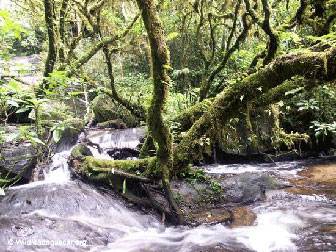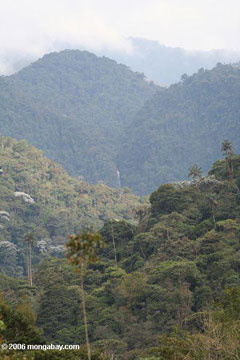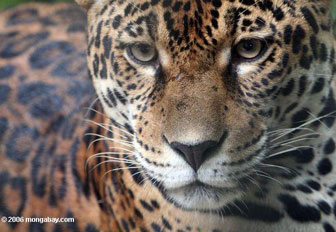Philosophical shift in conservation reintegrates humans in parks
Philosophical shift in conservation reintegrates humans in nature
Not all conservation is wilderness conservation
Rhett A. Butler, mongabay.com
February 28, 2007
Humans are among the most successful of Earth’s organisms. Living in every habitable, and sometimes uninhabitable, space, humans dominate the planet’s surface and have become a global force that alters natural ecosystems, species distribution, and climate. Virtually no wilderness areas have escaped man’s influence.
While past conservation efforts have focused on preserving “pristine” wilderness, it is increasingly apparent that few such areas exist. Recognizing this, present conservation efforts are increasingly looking at how human use fits into protected areas management. A new paper published in Biodiversity Conservation traces this shift in conservation philosophy since the 19th century. Reviewing the history of four main conservation approaches, Michelle Kalamandeen, a biologist at the University of Guyana, and Lindsey Gillson, a botanist at the University of Cape Town, conclude that current conservation efforts are integrating elements of each philosophy, resulting in a new conservation ethic that uses alternative criteria for designating and managing protected areas, and recognizes the importance of man’s influence in wilderness areas.
“The history of humans and the forests of our planet are tied together, often in a positive way,” Kalamandeen told mongabay.com via email. “Few protected areas are pristine wilderness, and our work shows that the protected areas system is starting to reflect this, by including knowledge of landscape history and people’s long-term influence on biodiversity.”
Kalamandeen and Gillson review four distinct conservation approaches — Wilderness Conservation, the Game Reserve Model, Wildlife and biodiversity conservation, and Ecosystem management — that have developed over the past 150 years or so:
Wilderness Conservation

Conservation no longer has to be a stark choice between biodiversity conservation, ecosystem management, and human well-being. Photos by Rhett A. Butler |
Kalamandeen and Gillson first examine the Wilderness conservation and the Yellowstone model, a strict approach based on the idea of pristine wilderness. Championed by the likes of John Muir, this model operated on the premise that humans always have a negative influence on landscapes and should not have any part in protected wilderness areas. As practiced, indigenous populations, like the Shoshones and Maasai, were booted from their ancestral lands in places like Yellowstone and Kenya in the interest of preserving the “natural” setting. Historically driven by the tourist industry as well as the Game Reserve Model mentioned below, the 1990s saw a backlash against “fortress conservation” strategies. Still by 2003, over 29,747 strictly Protected Areas covered over 6.7 million square kilometers worldwide, according to the authors.
Wise Use’ and the Game Reserve Model
The authors note that the rise of the Wilderness Movement was mirrored by the “advocacy for wise use’ of natural resources” an idea where protected areas would be managed responsibly for the long-term benefit to mankind. While the philosophy dated back to earliest origins of civilization, the concept was formalized in the United States by President Theodore Roosevelt when he created the national forest system. While the system proved controversial at times for granting seemingly privileged access for high-ranking members of society, Kalamandeen and Gillson note that the underlying concept was driven by utilitarian concerns over the use of natural resources.
Wildlife and biodiversity conservation
The authors write that over time the conservation rationale for protected areas designation and management “shifted from landscape, scenery and natural resources, to preservation of wildlife and biodiversity.” They say the change in focus “resulted from an interest in protecting animals for their own sakes, and for preserving species for science and for the potential and actual benefits in terms of genetic resources and ecosystem services. Initially, wildlife conservation was deeply entwined with humane and ethical concerns for animals, though in recent decades the ‘Animal Rights Movement’ has become somewhat separated from conservation, while scientific approaches to conservation have focused on concerns over biodiversity loss.” Kalamandeen and Gillson say these concerns culminated in the 1992 Convention on Biological Diversity (CBD) which squarely focused on biodiversity as a priority for conservation efforts.
Ecosystem management
Kalamandeen and Gillson write that in recent decades, as scientists have developed a better understanding of ecosystem dynamics, “there have been conceptual and theoretical shifts in conservation ecology with ideas of variability, flux and resilience gradually refining older ideas of equilibrium and balance… In contrast to earlier conservation approaches, ecosystem management is based on a paradigm of nature in flux, rather than balance, and a view of people within, rather than separate from, nature.”
Convergence
While these philosophies seem divergent, Kalamandeen and Gillson argue that there is common ground.

Rainforest in Colombia. Photo by Rhett A. Butler |
“Despite their apparently separate philosophical roots and rationales, the four approaches to conservation described here show considerable overlap in both underlying ecological assumptions and in the implications for PA designation (and management),” they write. “In all four approaches, PA designation is a key component of conservation strategy, and Wilderness is also a recurrent theme.”
They note that while humans have traditionally been viewed as having a detrimental impact on biological diversity, new studies suggest that in some areas researchers have found a surprising positive correlation between human population density and species richness. Further, say Kalamandeen and Gillson, there is growing evidence that “apparently pristine wilderness… bear the legacy of previous human occupation, or in some cases to actively depend on human management” For example, research conducted in the Amazon Basin suggests that vast areas of rainforest may have been managed by indigenous populations to promote areas of concentrated diversity of useful species within a diverse landscape.
Kalamandeen and Gillson say that these new findings, which reflect the importance of human influence of wilderness areas and biodiversity, are being incorporated into new approaches including those embodied in IUCN’s system of categorization of protected areas and UNESCO’s Man and the Biosphere Program.
“In recent decades… the ‘Flux of Nature’ paradigm and the development of an ecosystem management approach to conservation, as well as debates over ‘Parks vs. People’ has been reflected in the growing sophistication of PA designation and management,” the authors write. “Formerly centred on the idea of wilderness, freedom from human impact and stability, a range of models for conservation, both inside and outside of PAs, has now emerged. The most recent IUCN PA categories (V and VI, added in 1992), for example, indicates an increasing recognition of the value of cultural landscapes. This approach is complemented by the designation of World Heritage Sites and UNESCO’s Man and Biosphere Programme, which aims to specifically protect culturally significant landscapes and artefacts and to preserve the interconnectedness of human and natural systems.”
They note that even the Convention on Biological Diversity recognizes the “interconnectedness of human and natural systems” and seeks to combine “conservation of biological diversity and sustainable use” — concepts that would traditionally be beyond the scope of an agreement that focuses on biodiversity.
“Though scientific and biological criteria were and are a driving force in biodiversity conservation, it is clear that they are only part of the rationale for conservation,” Kalamandeen and Gillson continue. “Conservation goals were, and still are, built on the values, assumptions and priorities of conservationists, how they understood and interpreted the landscapes and ecosystems they sought to preserve and the way they perceived the relationship between humans and nature. A critical examination of assumptions, values and priorities of conservationists, as well as an examination of the historical links between ecological and social systems, will be central to developing conservation strategies that reconcile social, cultural and economic needs with conservation goals and the intrinsic limits of ecological systems,” they conclude.
Citation: Michelle Kalamandeen & Lindsey Gillson (2007). Demything ‘wilderness’: implications for protected area designation and management. Biodivers Conserv DOI 10.1007/s10531-006-9122-x
